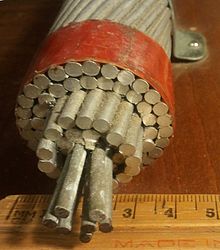Talk:Wire
| This is the talk page for discussing improvements to the Wire article. This is not a forum for general discussion of the article's subject. |
Article policies
|
| Find sources: Google (books · news · scholar · free images · WP refs) · FENS · JSTOR · TWL |
| Archives: 1 |
| This article is written in British English, which has its own spelling conventions (colour, travelled, centre, defence, artefact, analyse) and some terms that are used in it may be different or absent from other varieties of English. According to the relevant style guide, this should not be changed without broad consensus. |
| This It is of interest to the following WikiProjects: | ||||||||||||||||||
| ||||||||||||||||||
Primary wire
[edit]Unless it lacks notability, "primary wire" should be described in the 'Varieties' section. ZFT (talk) 03:57, 9 September 2020 (UTC)
History in UK
[edit]Taken from a usage viewpoint, the earliest use of hand carders is in the Luttrell Psalter (1320-40, Linolnshire). Recent excavations in the Amgidy valley suggest the Tintern wireworks were contemporary with the Abbey, per private correspondence with Will Davies, the CADW Inspector, who cites "early post-mediaeval". Recent discovery of culverting indicate the 1568 works expanding the existing mill runs to become leats were for a new artillery foundry closely connected with the Ordnance Board base at Monmouth, itself dating from at least 1415 (Shakespeare, Henry V): the wire works were older. The suggestion it was a Royal monopoly in the 1463 Edward IV interdiction of the export of wool combs is coherent with this.
wire vs wire rope
[edit]
I think it is misleading to call this picture from an overhead line conductor a "wire" as it is a "wire rope" and the whole rope consists of several wires. --Gunnar (talk) 06:22, 10 October 2021 (UTC)
- @Wtshymanski: "they don't call them ropes in this context", you wrote in [1]. As far as I know, a conductor rope ("5.6. Connection of the conductor rope to the cable bolt (A) or to the conductor rod (C)", [2] p. 11) is a wire rope made of conductive material, which is mechanically flexible. There is a difference between a "wire" and a "wire rope", as the first one only has one filament, whereas the latter has many many independent ones Wire rope#History adding redundancy and increasing reliability. --Gunnar (talk) 07:29, 18 October 2021 (UTC)
- Sounds like a bad translation. What do English-speaking sources say? --Wtshymanski (talk) 04:43, 28 October 2021 (UTC)
- Wikipedia articles that use British English
- Start-Class level-4 vital articles
- Wikipedia level-4 vital articles in Technology
- Start-Class vital articles in Technology
- Start-Class Technology articles
- WikiProject Technology articles
- Start-Class Materials articles
- Mid-importance Materials articles
- WikiProject Materials articles



